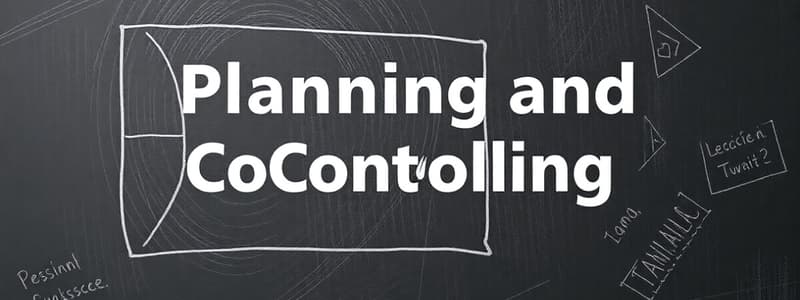Podcast
Questions and Answers
What is the primary purpose of planning in management?
What is the primary purpose of planning in management?
- To strengthen communication among staff
- To create a foundation for management functions (correct)
- To enhance the control process
- To allocate resources efficiently
Which of the following is NOT a benefit of planning?
Which of the following is NOT a benefit of planning?
- Enhances action orientation
- Strengthens control
- Encourages individual creativity without constraints (correct)
- Improves focus and flexibility
In the planning process, after defining your objectives, what is the next step?
In the planning process, after defining your objectives, what is the next step?
- Set short-range plans
- Assess current position (correct)
- Analyze action alternatives
- Develop premises
What characteristic defines long-range plans in management?
What characteristic defines long-range plans in management?
How does planning facilitate time management?
How does planning facilitate time management?
Strategic plans are characterized by which of the following aspects?
Strategic plans are characterized by which of the following aspects?
Which of the following aspects does NOT contribute to enhancing action orientation in planning?
Which of the following aspects does NOT contribute to enhancing action orientation in planning?
What is a key function of lower management in terms of planning?
What is a key function of lower management in terms of planning?
What is the primary difference between a policy and a procedure?
What is the primary difference between a policy and a procedure?
What are standing plans primarily designed for?
What are standing plans primarily designed for?
Which planning method involves preparing for various future scenarios?
Which planning method involves preparing for various future scenarios?
What does a contingency plan primarily address?
What does a contingency plan primarily address?
In scenario planning, how many different scenarios should an organization ideally create?
In scenario planning, how many different scenarios should an organization ideally create?
Which of the following best describes a budget in the context of planning?
Which of the following best describes a budget in the context of planning?
What can scenario planning help organizations achieve?
What can scenario planning help organizations achieve?
What situation would NOT typically invoke a contingency plan?
What situation would NOT typically invoke a contingency plan?
What is the first step in the control process?
What is the first step in the control process?
Which type of standard measures work efforts that go into a performance task?
Which type of standard measures work efforts that go into a performance task?
After measuring actual performance, what is the next step in the control process?
After measuring actual performance, what is the next step in the control process?
What is the control equation used in the comparison step of the control process?
What is the control equation used in the comparison step of the control process?
What aspect is evaluated during an after-action review?
What aspect is evaluated during an after-action review?
Which of the following best describes output standards?
Which of the following best describes output standards?
Why is accurate measurement of performance critical in the control process?
Why is accurate measurement of performance critical in the control process?
What does relative comparison utilize as an evaluation benchmark?
What does relative comparison utilize as an evaluation benchmark?
What kind of comparison uses past performance as a basis for evaluating current performance?
What kind of comparison uses past performance as a basis for evaluating current performance?
In engineering comparison, what primary method is used to set standards?
In engineering comparison, what primary method is used to set standards?
What does management by exception prioritize in the evaluation process?
What does management by exception prioritize in the evaluation process?
What is the purpose of feedforward control in management?
What is the purpose of feedforward control in management?
Which type of control focuses on problems as they occur during the work process?
Which type of control focuses on problems as they occur during the work process?
In the corrective action process, when should opportunities for improvement be addressed?
In the corrective action process, when should opportunities for improvement be addressed?
What is the focus of preliminary controls?
What is the focus of preliminary controls?
What is the goal of management by exception in practice?
What is the goal of management by exception in practice?
Flashcards
Planning Process
Planning Process
A structured method for setting objectives and figuring out how to reach them.
Objectives
Objectives
Specific results you want to achieve.
Short-range Plans
Short-range Plans
Plans for one year or less, often created by lower-level managers.
Long-range Plans
Long-range Plans
Signup and view all the flashcards
Strategic Plans
Strategic Plans
Signup and view all the flashcards
Planning Benefits: Focus/Flexibility
Planning Benefits: Focus/Flexibility
Signup and view all the flashcards
Planning Benefits: Coordination
Planning Benefits: Coordination
Signup and view all the flashcards
Planning Process Steps
Planning Process Steps
Signup and view all the flashcards
Policy
Policy
Signup and view all the flashcards
Procedure
Procedure
Signup and view all the flashcards
Standing Plan
Standing Plan
Signup and view all the flashcards
Scenario Planning
Scenario Planning
Signup and view all the flashcards
Contingency Plan
Contingency Plan
Signup and view all the flashcards
Budget
Budget
Signup and view all the flashcards
Scenario
Scenario
Signup and view all the flashcards
Planning Methods
Planning Methods
Signup and view all the flashcards
Control Process
Control Process
Signup and view all the flashcards
Establish Objectives and Standards
Establish Objectives and Standards
Signup and view all the flashcards
Output Standard
Output Standard
Signup and view all the flashcards
Input Standard
Input Standard
Signup and view all the flashcards
Measure Actual Performance
Measure Actual Performance
Signup and view all the flashcards
Compare Results with Objectives
Compare Results with Objectives
Signup and view all the flashcards
Historical Comparison
Historical Comparison
Signup and view all the flashcards
Corrective Action
Corrective Action
Signup and view all the flashcards
Relative Comparison
Relative Comparison
Signup and view all the flashcards
Engineering Comparison
Engineering Comparison
Signup and view all the flashcards
Management by Exception
Management by Exception
Signup and view all the flashcards
Opportunity Situation (Management by Exception)
Opportunity Situation (Management by Exception)
Signup and view all the flashcards
Feedforward Control
Feedforward Control
Signup and view all the flashcards
Concurrent Control
Concurrent Control
Signup and view all the flashcards
Preliminary Controls
Preliminary Controls
Signup and view all the flashcards
Study Notes
Planning - How and Why Managers Plan
- Planning is the process of setting objectives and determining how to achieve them.
- Planning creates a foundation for management functions.
- Planning includes:
- Defining objectives (specific desired outcomes)
- Assessing the current position (evaluating accomplishments)
- Developing premises/assumptions (anticipating future events)
- Analyzing action alternatives (listing and evaluating options to achieve objectives)
- Planning improves focus, flexibility, and adaptability to changing circumstances.
- Improves decision-making, action orientation, and a sense of direction.
- Planning helps with coordination, time management, and makes the control process more effective.
- Planning involves various methods, such as forecasting, contingency planning, scenario planning, and benchmarking.
Types of Plans
- Short-range plans: up to one year (Lower Management)
- Intermediate-range plans: 1-2 years
- Long-range plans: 3+ years (Top Management)
- Strategic plans: set broad, comprehensive, longer-term action directions; objectives for the entire organization. This includes SWOT, PEST, Porter's, and BCG analyses.
- Standing plans: policies and procedures designed for repeated use.
- Policies: broad guidelines for decision-making (e.g., hiring, performance appraisals, promotions, discipline).
- Procedures: specific actions to be taken in certain situations (e.g., handbooks, manuals).
Benefits of Planning
- Improves Focus and Flexibility: Helps organizations understand their strengths and customer needs. Enables individuals to stay committed to career goals despite challenges. Promotes adaptability to changing circumstances. This means knowing your strengths and weaknesses and having a plan for how to adapt when situations change.
- Enhances Action Orientation: This is a proactive approach that emphasizes taking initiative and focusing on results. It involves: creating a performance-oriented sense of direction, ensuring the most important things get priority, making sure resources are used to best advantage, and anticipating problems and opportunities.
- Improves Coordination: Aligns lower-level objectives with higher-level goals (means-end chain).
- Improves time management: Prioritizes tasks to manage time efficiently (e.g., to-do lists).
- Strengthens Control: Provides a framework for measuring progress and making improvements (e.g., specific benchmarks for comparison and correction strategies).
Planning Process
- Forecast: Analyzing trends and data to predict future events.
- Contingency planning: Developing alternative actions for unexpected events. For example, if a natural disaster takes place, moving business to another location.
Scenario Planning
- Prepares for various future scenarios (e.g., economic growth rates).
- Scenarios are not wild predictions; they are realistic descriptions of how external factors (politics, tech, economy) could change and interact in the future.
- Organizations create 3-4 different scenarios to explore possible future events. Analyze the opportunities and challenges of each scenario; help make informed short- and long-term strategic decisions.
- Example: assessing different potential economic growth scenarios, and preparing for each possibility.
Contingency Planning Example
- If a natural disaster occurs, relocate business to another location.
- If a competitor opens near, implement specific strategies to maintain market share.
Budget
- Plans that allocate resources for activities, serving as single-use plans.
- Example: a personal budgeting document.
Planning Methods
- Forecasting, contingency planning, scenario planning, benchmarking.
Studying That Suits You
Use AI to generate personalized quizzes and flashcards to suit your learning preferences.



